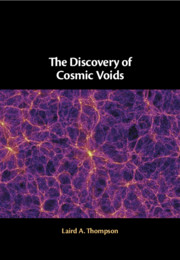Book contents
- The Discovery of Cosmic Voids
- The Discovery of Cosmic Voids
- Copyright page
- Dedication
- Contents
- Foreword
- Preface
- Acknowledgments
- Abbreviations
- 1 Understanding the Foundations of Modern Cosmology
- 2 Preview of the Discovery of Cosmic Voids
- 3 Homogeneity of the Universe: Great Minds Speak Out
- 4 All-Sky Surveys in the Transition Years 1950–1975
- 5 The Early Redshift Surveys from Arizona Observatories
- 6 Galaxy Mapping Attempt at Tartu Observatory
- 7 Theoretical Models of Galaxy Formation – East versus West
- 8 Priority Disputes and the Timeline of Publications
- 9 Impact of Cosmic Voids: Cosmology, Gravity at the Weak Limit, and Galaxy Formation
- Book part
- Notes
- Biographical Sketches
- References
- Index
1 - Understanding the Foundations of Modern Cosmology
Published online by Cambridge University Press: 02 December 2020
- The Discovery of Cosmic Voids
- The Discovery of Cosmic Voids
- Copyright page
- Dedication
- Contents
- Foreword
- Preface
- Acknowledgments
- Abbreviations
- 1 Understanding the Foundations of Modern Cosmology
- 2 Preview of the Discovery of Cosmic Voids
- 3 Homogeneity of the Universe: Great Minds Speak Out
- 4 All-Sky Surveys in the Transition Years 1950–1975
- 5 The Early Redshift Surveys from Arizona Observatories
- 6 Galaxy Mapping Attempt at Tartu Observatory
- 7 Theoretical Models of Galaxy Formation – East versus West
- 8 Priority Disputes and the Timeline of Publications
- 9 Impact of Cosmic Voids: Cosmology, Gravity at the Weak Limit, and Galaxy Formation
- Book part
- Notes
- Biographical Sketches
- References
- Index
Summary
The standard model of cosmology called LCDM has its origins in the work of great scientists including Einstein, Friedmann, Slipher, Hubble, Lemaitre, and Gamow. Lemaitre’s 1930s “Cosmic Egg” or “Primeval Nucleus” was the basis for the Big Bang model. In its new variant called LCDM, “L” represents the cosmological constant Lambda and “CDM” represents Cold Dark Matter. These two components, L and CDM, account for 95 percent of the mass–energy content of the Universe. Edwin Hubble correctly showed in the 1930s that galaxies are distributed on the largest scales in a homogeneous and isotropic way, but on a more local scale of 300 million light-years Hubble failed to recognize significant inhomogeneities. Hubble and Humason validated the velocity–distance relation for galaxies and galaxy clusters demonstrating the expansion of the Universe. They did not call out how significant the velocity–distance relationship would become in our effort to determine the 3D structure in the galaxy distribution.
Keywords
- Type
- Chapter
- Information
- The Discovery of Cosmic Voids , pp. 1 - 17Publisher: Cambridge University PressPrint publication year: 2020



